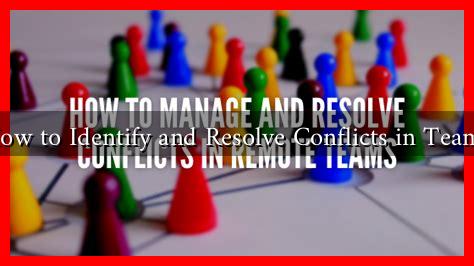-
Table of Contents
- How to Identify and Resolve Conflicts in Teams
- Understanding the Nature of Conflict
- Identifying Conflicts Early
- Effective Conflict Resolution Strategies
- 1. Foster Open Communication
- 2. Focus on Interests, Not Positions
- 3. Mediation and Facilitation
- 4. Establish Clear Guidelines
- Case Study: Google’s Approach to Conflict Resolution
- Conclusion
How to Identify and Resolve Conflicts in Teams
Conflict is an inevitable part of teamwork. Whether it arises from differing opinions, competition for resources, or personality clashes, unresolved conflict can hinder productivity and damage relationships. However, when managed effectively, conflict can lead to growth, innovation, and stronger team dynamics. This article explores how to identify and resolve conflicts in teams, providing practical strategies and insights.
Understanding the Nature of Conflict
Before diving into conflict resolution, it’s essential to understand the types of conflicts that can arise within teams. Conflicts can generally be categorized into three types:
- Task Conflict: Disagreements about the content and outcomes of the work.
- Relationship Conflict: Personal disagreements that stem from interpersonal issues.
- Process Conflict: Disputes over how tasks should be completed.
Recognizing the type of conflict is crucial for determining the appropriate resolution strategy. For instance, task conflicts can often lead to constructive discussions, while relationship conflicts may require more delicate handling.
Identifying Conflicts Early
Early identification of conflicts can prevent escalation. Here are some signs that conflict may be brewing within a team:
- Increased tension or hostility among team members.
- Frequent misunderstandings or miscommunications.
- Declining morale or motivation.
- Changes in behavior, such as withdrawal or aggression.
Regular check-ins and open communication can help team leaders spot these signs early. Tools like anonymous surveys or one-on-one meetings can provide insights into team dynamics and potential issues.
Effective Conflict Resolution Strategies
Once a conflict is identified, it’s essential to address it promptly and effectively. Here are some strategies for resolving conflicts in teams:
1. Foster Open Communication
Encouraging team members to express their thoughts and feelings openly can help clarify misunderstandings. Create a safe environment where everyone feels comfortable sharing their perspectives. Techniques such as active listening and paraphrasing can ensure that all voices are heard.
2. Focus on Interests, Not Positions
Encourage team members to discuss their underlying interests rather than their positions. This approach can lead to more collaborative solutions. For example, if two team members are arguing over project leadership, exploring their motivations—such as a desire for recognition or a passion for the project—can help find a compromise that satisfies both parties.
3. Mediation and Facilitation
Sometimes, conflicts may require a neutral third party to mediate. A facilitator can help guide the conversation, ensuring that it remains constructive and focused on resolution. This approach is particularly useful in relationship conflicts where emotions may run high.
4. Establish Clear Guidelines
Setting clear expectations and guidelines for team interactions can prevent conflicts from arising. Establishing norms around communication, decision-making, and conflict resolution can create a more harmonious team environment.
Case Study: Google’s Approach to Conflict Resolution
Google is renowned for its innovative workplace culture, which emphasizes open communication and collaboration. The company employs a unique approach to conflict resolution through its “Project Aristotle,” which studies team dynamics. The findings suggest that psychological safety—where team members feel safe to take risks and express their ideas—is crucial for effective conflict resolution. By fostering an environment of trust, Google has been able to turn potential conflicts into opportunities for growth and innovation.
Conclusion
Conflict in teams is not inherently negative; it can be a catalyst for improvement and innovation when managed effectively. By identifying conflicts early, fostering open communication, focusing on interests rather than positions, and establishing clear guidelines, teams can navigate conflicts successfully. As demonstrated by Google, creating a culture of psychological safety can transform conflicts into opportunities for collaboration and growth. Embracing conflict as a natural part of teamwork can lead to stronger relationships and enhanced productivity.
For further reading on conflict resolution strategies, consider exploring resources from the Mind Tools website.

